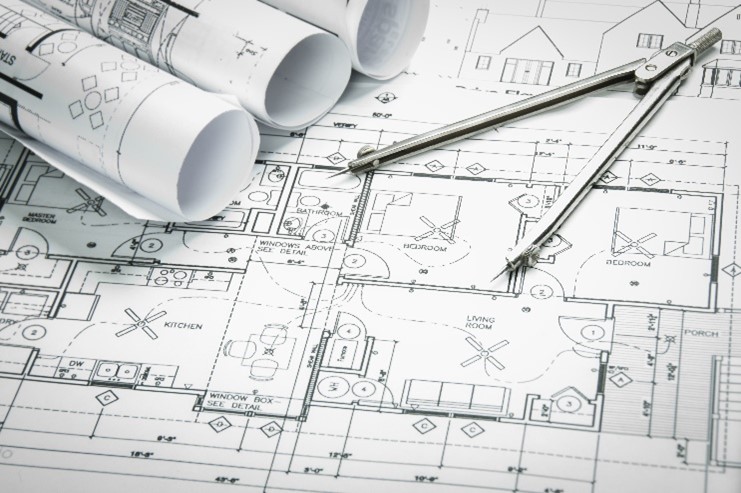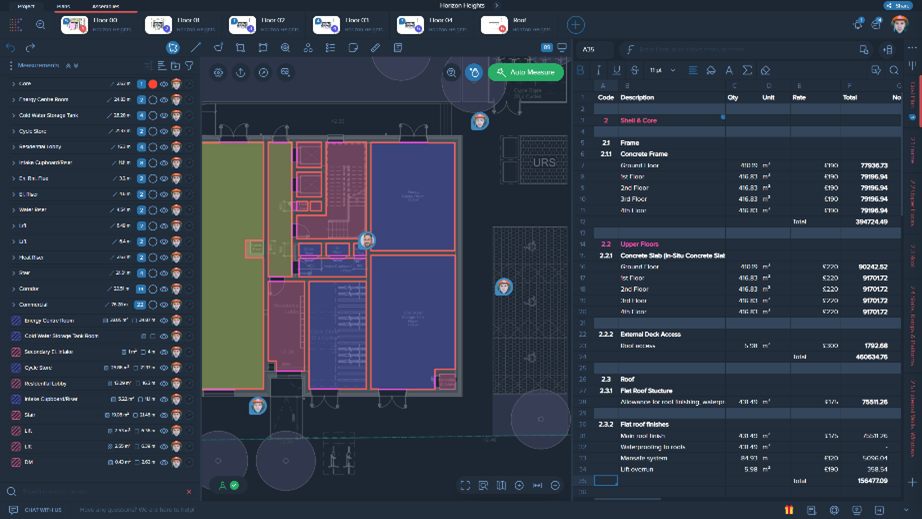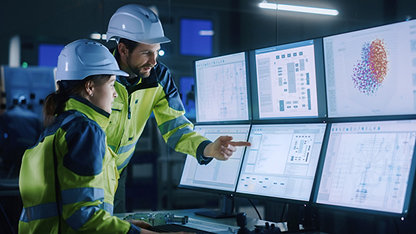We live in an era where technological advancements are reshaping industries at an unprecedented pace. As a result, the practice of quantity surveying may be standing on the cusp of a profound transformation.
A new era
Artificial intelligence (AI) promises to revolutionise the traditional practices and responsibilities of quantity surveyors (QSs). From cost estimation to project management, AI-powered tools and algorithms will streamline processes, enhance decision-making, and unlock new possibilities.
It is important to explore how this innovative, and arguably disruptive, technology might shape the future of quantity surveying and redefine the role of these professionals across the construction landscape.

The role of a quantity surveyor
A QS’s role is crucial within the construction industry. Their primary responsibility is to manage and control the costs associated with construction projects.
‘This will initially involve the capital expenditure phase of a building or facility, from feasibility to design and construction [but they] can also be involved with extensions, refurbishment, maintenance and demolition of a facility.’ RICS, Quantity surveying and construction pathway guide, August 2018.
A QS’s key responsibilities include:
- cost estimation
- cost planning
- procurement and tendering
- value engineering
- contract administration
- cost control and monitoring and
- final account settlement.
For more details on a QS’s role, see Quantity surveying: Your guide to becoming a quantity surveyor..

What is AI and how is it being used?
AI is a revolutionary field that aims to create computer systems capable of performing tasks that typically require human intelligence. From speech recognition to problem-solving, AI has the potential to transform various industries and improve our daily lives.
According to Futurism, the progress of AI can be understood in three distinct waves, each representing a significant leap forward in its capabilities.
- The first wave saw algorithms and software based on experts’ own knowledge, but these systems struggled to adapt to uncertainty.
- The second wave brought forth statistical learning, where models were trained on vast amounts of data to improve accuracy. However, despite impressive results, the systems’ inner workings lacked a clear understanding of how they reached their conclusions.
- The third wave of AI was marked by sophisticated AI systems that could understand and respond to the context of a situation. However, development of these advanced systems required extensive research and innovation.
Today, we are in the fourth wave of AI, with generative models like ChatGPT and large language models catalysing transformative advancements across various domains. Natural language processing (NLP) allows virtual assistants like Siri and Alexa to respond to spoken or written commands. Image and video recognition enable automated tagging, content filtering and visual search capabilities, benefiting areas like self-driving cars and social media.
NLP can also be used in the workplace. Voice recognition can be used in meetings, allowing for automated transcripts, notes and documentation. Documents can also be transferred into structured data, which could be a huge benefit to a range of surveying professions. Moreover, AI's integration into robotics has opened doors to tangible applications, enhancing tasks in manufacturing, healthcare and beyond.

As AI continues to advance, we can expect further breakthroughs and possibilities. The future holds the promise that AI systems will not only surpass human capabilities but also possess a deep understanding of the world, providing us with remarkable insights and transforming the way we live and interact with technology.
How will AI shape the role of a quantity surveyor?
Automating complex tasks
A key area where AI can bring significant value is in automating complex and time-consuming tasks. For instance, cost forecasting can be expedited through AI-driven analysis of historical data, market trends and relevant variables. Machine-learning algorithms can unveil patterns and correlations that lead to more precise cost estimates and predictions, enabling QSs to provide accurate financial projections for construction projects.

Enhancing quantity takeoff
AI's capacity to analyse historical project data and employ machine-learning algorithms can dramatically improve the accuracy of quantity takeoff (QTO) estimates. This not only optimises efficiency but also ensures a more reliable foundation for budgeting and planning. For example, Kreo Software, a member of the RICS Tech Partner Programme, has developed Kreo 2D Takeoff, a powerful cloud-based software specifically designed to assist in the process of QTO (see RICS’ chat with Kreo). This software allows users to manage all their projects in one place while automating routine tasks and bringing together their preferred productivity tools. With a familiar Excel-like environment, the software incorporates the following AI tools that enhance the QTO process.
- Auto measure: this defines all areas and elements on drawings and groups them by type within minutes of its launch.
- AI suggest: this predicts specific measurements right from the initial point specified by the user.
- Auto count: this helps to quickly locate and count objects or text on drawings similar to the selected one.
- Auto scale: this algorithm suggests an appropriate scale for a particular drawing based on its unique characteristics.
- Caddie AI: integration with ChatGPT allows you to ask questions about drawings and other documents in clear language.

Improved communication and interaction
The integration of AI-powered chatbots and NLP technologies can revolutionise stakeholder interactions. AI chatbots and NLP capabilities, like Zendesk Answer Bot, can significantly support QSs in their interactions with stakeholders. Zendesk Answer Bot can automate responses to routine inquiries from clients, site managers and project managers. The chatbot can efficiently handle questions related to project updates, cost estimates and other common inquiries. Additionally, its NLP capabilities enable it to assist in information retrieval, accessing relevant construction and cost data from the firm's database.
This automation streamlines communication and frees up valuable time for QSs to concentrate on more complex tasks and strategic decision-making. As a result, better communication with stakeholders is facilitated, leading to improved client relations and enhanced project management efficiency.
Optimising documentation tasks
Administration tasks that involve producing and updating documents can consume many working hours. AI can streamline the process of preparing tender and contract documents, budget reports and many more documents and reports. NLP algorithms can automatically generate standardised sections of contracts, allowing QSs to optimise their time with more important tasks. Similarly, AI systems can save time for QSs in budget reporting by gathering the data, performing calculations and generating reports.
Bridging BIM and AI for efficiency
The synergy between AI and building information modelling (BIM) holds immense promise for the construction industry. AI algorithms can utilise BIM data to optimise design, identify clashes between components and ensure compliance with industry standards and regulations. This integration enhances efficiency, minimises costs and contributes to sustainable construction practices.
BIM plays a crucial role in capturing and managing information throughout the project life cycle and can integrate seamlessly with AI. Computer vision systems, powered by AI, can utilise BIM and site data to inspect and monitor construction quality, detect defects and deviations from building regulations and the intended BIM design.
Skanska, a multinational construction and development company, implemented AI integration with BIM during the HS2 project. Through AI, BIM processes were automated to stimulate design options with different construction materials, replacing manual 3D drawing measurements. This allows for precise visualisation, measurement and comparison of carbon emissions and environmental impacts, leading to more environmentally friendly solutions.
Skanska's innovative approach demonstrates their commitment to sustainable construction practices and sets an example for the industry's future.
“The results will deliver carbon and cost savings across the whole construction sector as the tool will enable projects to leverage the full benefits of BIM and empower teams to design for cost and carbon efficiency.”
Skanska
Another example is ALICE Technologies, an RICS Tech Partner (see RICS’ chat with ALICE). ALICE is the world's first AI platform that understands construction. It works directly with 3D BIM and employs a simple rules-based system to explore millions of different schedule sequences. By using AI, construction teams can quickly answer ‘what if?’ scenarios and completely reschedule projects in just minutes.
With ALICE's AI-powered scheduling capabilities, construction companies can keep their crews flowing efficiently on projects of any size, leading to faster and more cost-effective construction. The integration of AI with BIM allows for precise visualisation and measurement, enabling teams to compare different construction materials' carbon emissions and environmental impacts. By incorporating sustainability considerations, ALICE empowers teams to design for both cost and carbon efficiency, aligning with the industry's growing focus on environmentally friendly solutions.

AI can also leverage data from Internet of Things (IoT) sensors installed on construction sites to monitor health and safety compliance. Onwave, an RICS Tech Partner (see RICS’ chat with Onwave), specialises in providing connectivity solutions for various industries, including construction. They offer IoT connectivity services that enable the seamless integration of sensors and devices on construction sites. These IoT sensors can collect real-time information about various aspects, such as noise levels, temperature, air quality and worker activities. This data is transmitted efficiently and securely to an AI-powered monitoring system.
Onwave analyses the collected data and compares it with established safety standards and regulations. If any potential safety issues are detected, the system raises immediate alerts to the relevant personnel onsite. It can also provide recommendations to maintain compliance with safety regulations and mitigate potential risks.
By implementing such a proactive monitoring system, construction companies can significantly improve overall safety on their sites and reduce the risk of accidents or non-compliance. Onwave's expertise in providing reliable and high-speed connectivity ensures that the data from IoT sensors is effectively utilised to enhance health and safety practices in the construction industry.
AI for sustainability
AI's contribution to sustainability is exemplified by its integration with BIM to optimise design options for construction materials and minimise environmental impact. Companies like Skanska, ALICE and Kreo showcase how AI-driven solutions can foster environmentally friendly construction practices, aligning with the industry's growing emphasis on sustainability.
The use of AI in construction reflects the industry's commitment to embracing innovative technologies to drive efficiency, safety and environmental responsibility. As AI continues to evolve and shape the construction landscape, collaboration between key stakeholders and experts within the built environment will be essential to unlock its full potential and drive the sector towards a more sustainable and technologically advanced future.
However, it is important to note that, while AI can automate certain aspects of a QS's role, the human expertise and judgement of QSs will remain crucial. AI tools should be seen as supportive tools to enhance productivity, accuracy and decision-making rather than replacing the role entirely.
How should quantity surveyors upskill?
QSs can upskill by focusing on enhancing their technology and data skills. By developing proficiency in software tools, data analysis and project management systems, they can adapt to the changing demands of their profession.
While there is an argument that QSs don’t need to become data scientists, they will need to work with them and increase their skills and knowledge of the AI-driven tools that already exist and will be deployed over the coming years.
QSs should become experts or develop proficiency in the following:
- AI-integrated BIM software, such as Autodesk BIM 360, Bentley Aecium, Trimble Connect and PlanGrid, which allow construction data in projects to be effectively managed and analysed. Explore functionalities in automating tasks, generating insights from data and enhancing collaboration among project stakeholders. Also consider software certifications/training to deepen your understanding and proficiency
- AI-driven computer-aided design (CAD) software, such as AutoCAD or SketchUp, to streamline design processes and optimise project outcomes
- data analysis and AI tools, such as Python's machine-learning libraries, Tableau with AI extensions or AI-driven data analysis in Microsoft Excel, to derive meaningful insights from construction data
- AI-based project management software, such as Primavera P6 with AI extensions or Microsoft Project's AI capabilities, which enable efficient resource allocation, risk assessment and project scheduling
- AI in construction cost estimating software, such as CostX with AI modules or AI-enhanced RSMeans, to improve accuracy and efficiency in cost estimation
- sustainable construction with AI: develop knowledge of AI applications in sustainable construction practices, such as AI-driven energy optimisation algorithms or AI-powered waste-reduction strategies, aligning with green building rating systems like LEED or BREEAM
- continuous professional development in AI: attend workshops, seminars, webinars and conferences focused on AI's applications in the construction industry. Keep informed about the latest AI trends and innovations and
- AI-related professional certifications that demonstrate your expertise in AI integration within the field of quantity surveying, and those specifically related to AI in construction, AI-driven project management or data analysis with AI. (Both online and face-to-face courses are currently offered, for example, the Knowledge Academy’s Artificial Intelligence (AI) for Project Managers – United Kingdom.)
Transforming the role
QSs are already highly valuable subject matter experts in the construction industry, but they have the potential to further enhance their skills with the advent of AI. Their expertise in cost management, contract oversight and procurement is crucial, and AI can act as a supportive tool to augment their capabilities. By embracing professional development opportunities, particularly in areas such as contract law, sustainable construction practices, leadership, and project management, QSs can take on more significant roles within their organisations. Upskilling in leadership and project management will empower them to lead project teams, drive innovation and ensure successful project delivery. With AI as a strategic enabler, QSs can focus on decision-making, collaboration and shaping sustainable built environments, solidifying their position as highly skilled professionals in the industry.
Lastly, developing leadership and project management skills enables QSs to take on more senior roles and lead teams effectively. Continuous learning and staying updated with industry trends and best practices are essential for QSs to thrive in their profession.
In summary, AI will not ‘take over’ or remove the role of the QS; instead, the role will transform and evolve. But it will be important for QSs to upskill and to keep up to date with both technological and sector trends.
QSs can also play a key role in working with developers of AI to ensure that the models and approaches provide real value to the sector and that the deep domain knowledge they possess complements the technology knowledge and skills of the data scientists.













